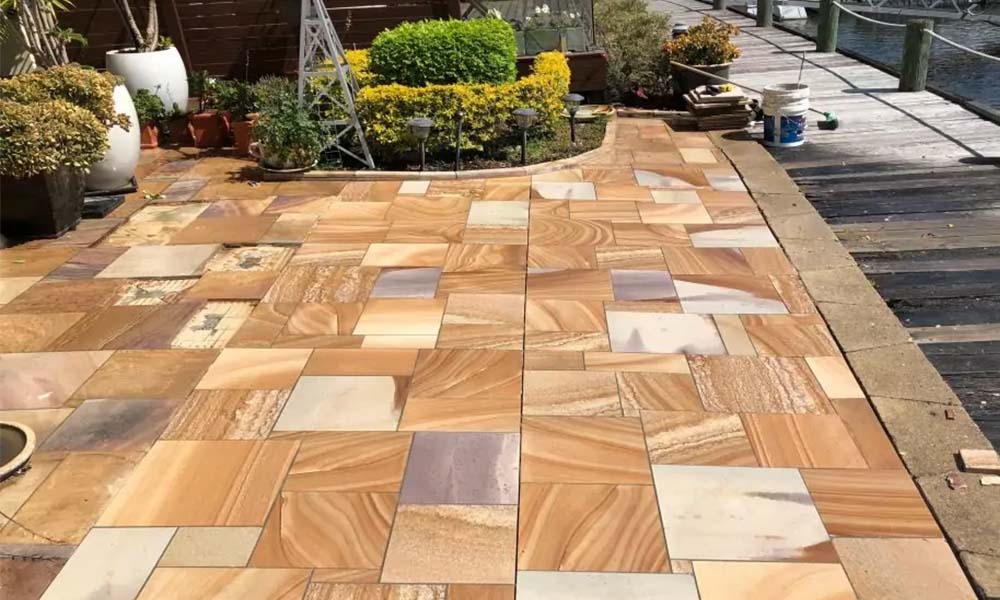
Many Australians are dreaming of transforming their backyards into beautiful, functional havens. And guess what? Outdoor pavers are the perfect way to bring those dreams to life, offering a simple yet impactful solution to enhance any outdoor area.
Why Choose Outdoor Pavers?
Versatility in Design
One of the biggest advantages of outdoor pavers is their incredible versatility. Unlike traditional concrete slabs, pavers come in a dazzling array of colours, textures, shapes, and sizes. This variety allows you to choose a design that perfectly complements your home’s architectural style and personal taste.
Durability to Withstand the Elements
Australia’s weather can be notoriously harsh, with scorching summers, heavy rainfall, and the occasional hailstorm. Outdoor pavers are designed to withstand these challenging conditions. Made from durable materials like concrete, stone, or clay, they are tough enough to handle the extremes of Aussie weather without cracking or fading.
Low Maintenance for Hassle-Free Living
When it comes to outdoor spaces, nobody wants to spend their weekends scrubbing and cleaning. Outdoor pavers are a low-maintenance option that requires minimal effort to keep looking great. A quick sweep to remove debris and a hose down every so often are usually all that’s needed.
For added protection against stains and weathering, you can apply a sealant, but even this is a simple process that doesn’t require professional help. This makes pavers an ideal choice for those who want a beautiful backyard without the upkeep.
Customizability for a Personal Touch
With outdoor pavers, you have the freedom to get creative. You’re not limited to standard shapes or colours; instead, you can mix and match to create patterns, borders, and even intricate mosaics that reflect your personality.
The possibilities are endless, whether you want to highlight a particular area of your yard or create a seamless flow from one section to another. This level of customizability allows you to design a space that’s uniquely yours, one that fits your lifestyle and aesthetic preferences perfectly.
Choosing the Right Pavers for Your Backyard
Selecting the right pavers is crucial to achieving your desired look and functionality. Here are some key factors to consider:
Material Options
Pavers come in a variety of materials, each with its own unique set of benefits. Here’s a breakdown of the most popular options:
- Concrete Pavers: These are the most common and budget-friendly option. They’re strong, durable, and available in a wide range of colours and styles. Concrete pavers can mimic the look of natural stone or brick at a fraction of the cost, making them a versatile choice for any project.
- Natural Stone Pavers: For those looking to add a touch of elegance and luxury to their backyard, natural stone pavers are an excellent choice. Materials like sandstone, granite, and limestone offer unique textures and colours that can’t be replicated by man-made products. They’re also incredibly durable, making them ideal for high-traffic areas.
- Clay Pavers: Made from natural clay, these pavers offer a rustic, earthy aesthetic that’s perfect for traditional or country-style homes. Clay pavers are also eco-friendly and have a timeless appeal that never goes out of style.
- Brick Pavers: Known for their durability and classic appeal, brick pavers are a versatile option that can be used in a variety of settings. They’re available in a range of colours and sizes, allowing you to create everything from traditional walkways to modern patios.
Style and Design
The style of your pavers should complement the overall design of your home and backyard. Consider whether you prefer a modern, minimalist look with clean lines and large pavers or a more traditional design with smaller, intricately patterned pavers.
The choice of paver style will set the tone for your entire outdoor space, so take the time to explore different options and find the one that resonates with you.
Size and Shape
The size and shape of the pavers you choose will have a significant impact on the final look of your project. For a classic, formal appearance, opt for rectangular or square pavers that can be laid in a uniform pattern.
If you’re after a more contemporary or organic feel, consider larger, irregular-shaped pavers that can be arranged in a free-form design. Remember, larger pavers can make a small space feel bigger, while smaller pavers can add detail and interest to larger areas.
Colour and Texture
The colour and texture of your pavers should complement the existing elements in your backyard, such as your home’s exterior, landscaping, and hardscaping features.
Darker pavers can create a striking contrast against lighter elements, while lighter pavers can help to brighten up a shaded area. Consider the climate in your region as well; darker pavers will absorb more heat, which may be uncomfortable in hot weather.
Designing Your Backyard Oasis with Outdoor Pavers
Now that you’ve chosen your pavers, it’s time to start designing your dream backyard. Here are some ideas to inspire you:
Create a Functional Patio
A paved patio is the heart of any outdoor space. It provides a solid, level surface for dining, lounging, and entertaining. When designing your patio, consider how you’ll use the space. Will it be an extension of your indoor living area, or a separate retreat? Choose pavers that complement your home’s interior design, creating a seamless transition between indoors and outdoors.
Define Pathways and Walkways
Pavers are perfect for creating pathways that lead visitors through your garden, connecting different areas like a fire pit, vegetable patch, or water feature. A well-designed pathway not only adds functionality but also enhances the overall aesthetics of your backyard. Consider using different shapes or colours to create a sense of direction and flow.
Enhance Your Pool Area
If you have a pool, surrounding it with pavers can create a safe, stylish, and comfortable lounging area. Choose non-slip pavers with a cool surface to ensure they’re safe and comfortable to walk on, even on hot summer days. You can also use pavers to create an integrated seating area or outdoor kitchen, making your pool area the ultimate entertaining space.
Maintenance Tips for Your Pavers
To keep your outdoor pavers looking their best, follow these simple maintenance tips:
- Regular Sweeping: Keep your pavers free of leaves, dirt, and debris by sweeping regularly. This prevents organic matter from breaking down and staining the pavers.
- Hose Down Occasionally: A gentle rinse with a hose will help to remove dirt and grime. For tougher stains, a pressure washer can be used, but be careful not to damage the surface of the pavers.
- Seal Your Pavers: Sealing your pavers every few years can help to protect them from stains, fading, and weathering. Be sure to use a sealant that’s appropriate for the type of pavers you have.
- Address Weeds and Moss: If weeds or moss start to grow between your pavers, remove them promptly. You can use a weed killer or a mixture of vinegar and water to prevent regrowth.
If you’re ready to start your outdoor paver project, Elite Sandstone is here to help. With our wide range of high-quality sandstone pavers and expert advice, we can guide you through every step of the process. Contact us today to get started on creating your dream backyard oasis!




